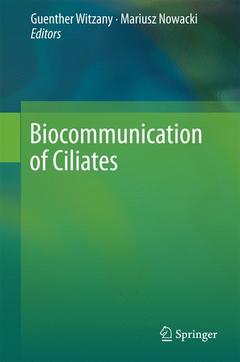Description
Biocommunication of Ciliates, 1st ed. 2016
Coordinators: Witzany Guenther, Nowacki Mariusz
Language: English
Subjects for Biocommunication of Ciliates:
Publication date: 05-2016
Support: Print on demand
Publication date: 05-2018
Support: Print on demand
Description
/li>Contents
/li>Comment
/li>
This is the first coherent description of all levels of communication of ciliates. Ciliates are highly sensitive organisms that actively compete for environmental resources. They assess their surroundings, estimate how much energy they need for particular goals, and then realise the optimum variant. They take measures to control certain environmental resources. They perceive themselves and can distinguish between ?self? and ?non-self?. They process and evaluate information and then modify their behaviour accordingly.
These highly diverse competences show us that this is possible owing to sign(aling)-mediated communication processes within ciliates (intra-organismic), between the same, related and different ciliate species (inter-organismic), and between ciliates and non-ciliate organisms (trans-organismic). This is crucial in coordinating growth and development, shape and dynamics.
This book further serves as a learning tool for research aspects in biocommunication in ciliates. It will guide scientists in further investigations on ciliate behavior, how they mediate signaling processes between themselves and the environment.
1. Introduction: Why biocommunication of Ciliates?.- 2. Principles of intracellular signaling in ciliated protozoa - a brief outline.- 3. RNA-guided genome editing.- 4. Intracytoplasmic signaling from cilia in ciliates.- 5. Chemotaxis as an expression of communication of Tetrahymena.- 6. Signals regulating vesicle trafficking in Paramecium cells.- 7. How do cysts know when to hatch? The role of ecological communication in awakening latent life.- 8. Hormonal communication of Tetrahyment.- 9. Signaling through GPI-anchored Proteins in Ciliates.- 10. Ciliate communication via water-borne pheromones.- 11. Communication in Tetrahymena Reproduction.- 12. Cell-cell interactions leading to establishment of a mating junction in Tetrahymena and Paramecium, two "contact-mediated" mating systems.- 13. Mating systems and reproductive strategies in Tetrahymena.- 14. Social information in cooperation and dispersal in Tetrahymena.- 15. Symbiotic associations in ciliates: ecological and evolutionaryperspectives.- 16. Paramecium as a model organism for studies on primary and secondary endosymbioses.- 17. An integrated model of the biology of the marine symbiosis Maristentor dinoferus.- 18. Interactions between parasitic ciliates and their hosts: Ichthyophthirius multifiliis and Cryptocaryon irritans as examples.- 19. Ciliates in planktonic food webs: communication and adaptive response.
These books may interest you

Biocommunication of Archaea 158.24 €

Biocommunication of Archaea 158.24 €

Biocommunication of Phages 189.89 €

